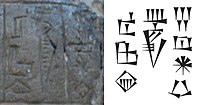Ikun-Shamash
Ikun-Shamash
King of Mari
Ikun-Shamash or Iku-Shamash (𒄿𒆪𒀭𒌓)[2] was a King of the second Mariote kingdom who reigned c. 2500 BC.[3] According to François Thureau-Dangin, the king reigned at a time earlier than Ur-Nanshe's of Lagash.[3] He is one of three Mari kings known from archaeology, and probably the oldest one.[2] Another king was Iku-Shamagan, also known from a statue with inscription, in the National Museum of Damascus.[2] The third king is Lamgi-Mari, also read Išgi-Mari, also known from an inscribed statue now in the National Museum of Aleppo.[4][5]
In his inscriptions, Ikun-Shamash used the Akkadian language, whereas his contemporaries to the south used the Sumerian language.[2] His official title in the inscriptions was "King of Mari" and "ensi-gal", or "supreme Prince" of the deity Enlil.[2]
He is known from a statue with inscription, which he dedicated to god Shamash.[2]
Ikun-Shamash's territory seems to have included southern Babylonia.[6]




